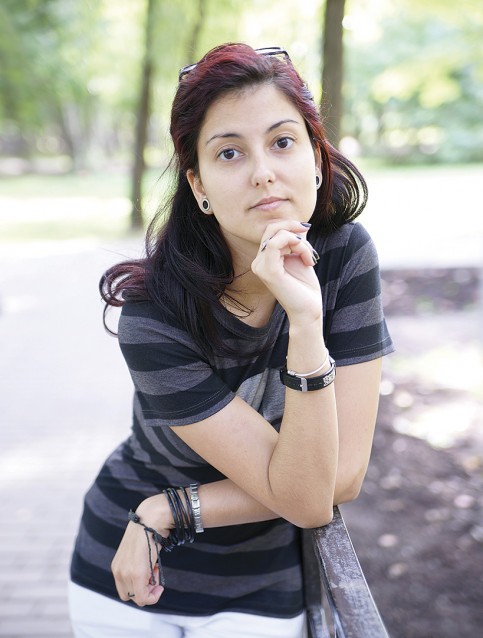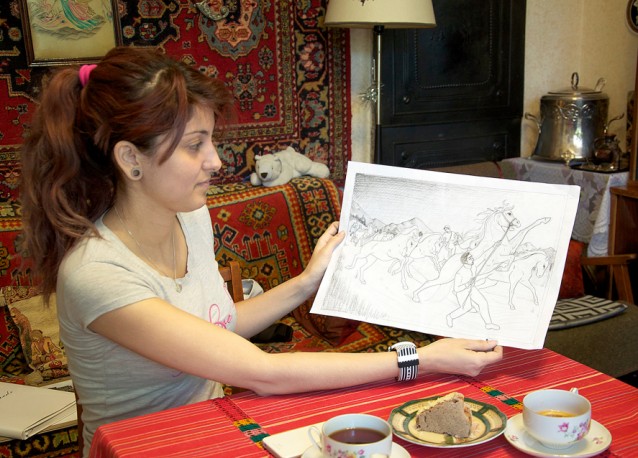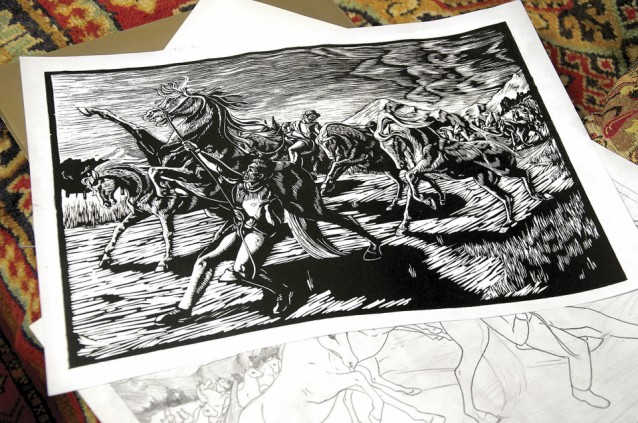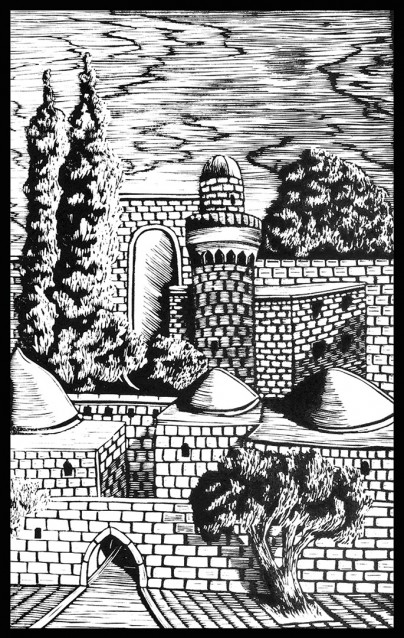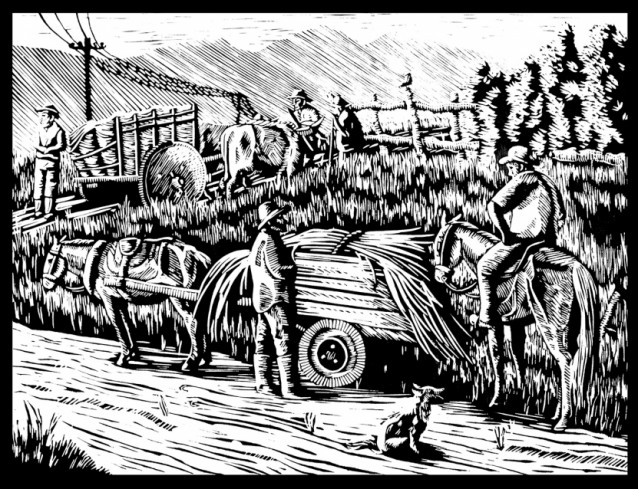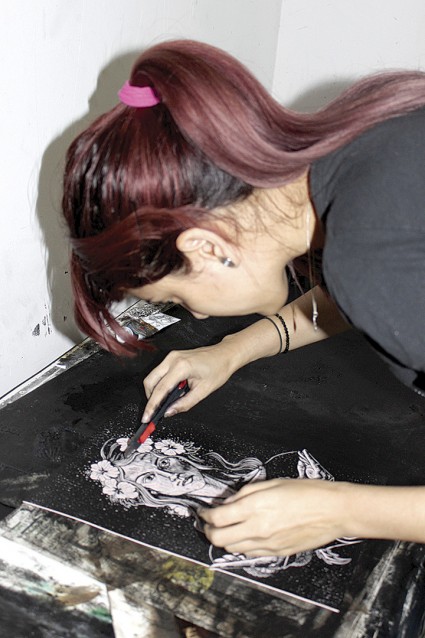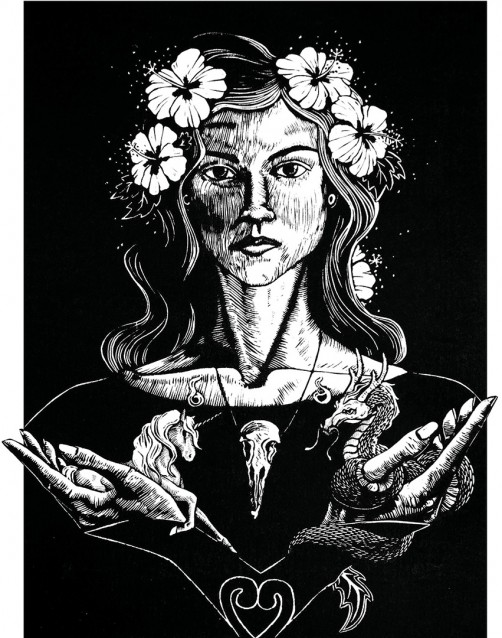Our summer edition reviewed the Art Rising exhibition of young artists, but Ian Peart and Narmin Babayeva were especially intrigued by a vibrant black and white linoprint of frenzied horses. Titled “Karabakh” it was by one Daniela Perera, whose name also teased. Could this be an illustration of the daring wartime rescue of the Aghdam stud? Daniela explained over tea and cake in her Baku apartment....
Daniela Perera, in her own words:
I was born in Cuba, in Havana in 1991; my mum says I have been drawing all my life. My father was studying here at the Marine Academy and my mother was teaching Russian there; they met and they fell in love. They went back to Cuba after he finished at the academy.
I lived the first part of my life there and the first time I came here was to visit my grandparents when I was in 4th grade. I lived in Cuba until I was 20, then I went to other places. I was in Moscow with my grandma and after that I came here to study in the Art Academy, about four years ago.
Winding back, Daniela told us how she had had no idea of what she wanted to do, even after attending a drawing school for two years and studying to be a tattoo artist, working at that for four years. She finally applied for university preparation courses, but was five years too late and she had left Cuba for Moscow.
Then I came here and stayed with my grandparents. They had a close friend who said, “Why don’t you go to university here, and you can be professional?’’ I didn’t know what to do, so I said “Yes, maybe.” And I took my works to the academy and they said, “Ok, you can start now.” I didn’t have my papers or anything, so I went back to Cuba and got all my papers, came back and started to work.
Where does your art come from? Was it just natural for you to draw?
I don’t know how it all started; one thing led to another. I was thinking of being a designer at the beginning, but I chose graphics because I really like to work in black and white and so graphics was better for me.
And Kabuki theatre? That’s obviously a current theme.
I am a very big fan of Japanese culture. I saw Kabuki theatre one time and fell in love with it. It was here, with a friend, and there was one part Kabuki theatre and one part Azerbaijani mugham. I really like their expressions, how they move. They are not just dramatic; they have three kinds: they have drama, comic and dancing. I really like it. It’s more about how they move, how they talk.
I was born in Cuba, in Havana in 1991; my mum says I have been drawing all my life
Horses....
We turned to the print of the horses that had made such an impression. Daniela explained that it was indeed an illustration of the dramatic rescue of 160 Karabakh horses in 1993. Six men rode them to safety through the night after the main Aghdam stud came under re from invading Armenian forces. Her class at the Art Academy had been set an assignment to illustrate the Nagorno-Karabakh conflict.
I didn’t really know much about it. I know about the situation in Karabakh, but no one has explained [in detail]. They tried to explain but I didn’t fully understand at that time. I went to one of my teachers and I asked him “How can I do it if I don’t know this story? I can’t give the feeling if I don’t know what happened.”
He told me what happened there and I thought that I could create that moment when they took the Karabakh horses out, because I thought that it’s like you are taken out of your own country, and just to take the last things you care about before the Armenians come.
And so I did that moment because the horses are running.... and you can see in the sky it’s getting.... darker. It’s symbolic that something bad is coming. I wanted to make it a representation, not [show] war.
I did it as I think it was. It’s showing the fear in their mind and the difficulties. I would really like to meet someone who was there and knows more about it....
Warming to her story, Daniela scurried about looking for her sketches that illustrate the process of making the final picture.
This was my first picture.... I was thinking of making a horse in the middle and two horses at the back. But afterwards, I thought that was going to be too centred and boring, not that interesting. I thought I had to make it more representative – if the horse is in the centre, it’s just a horse, but I need to represent everything, not just a horse.... So I presented this.... I really like this one more.... When you talk about Karabakh, everyone is always only thinking about the war and everything, but maybe you can work on how the people lived there in that time, how everything was. And I just wanted to represent that moment with the horses.... I don’t want to be like everyone, I want to touch – yes, they do it too, but I want to make it on my own. And I’m a foreigner, I can do it like how I see it from this side.
I saw the Karabakh horses one time. The first time I thought about them was when I read Ali & Nino, it describes the horses and I tried to imagine how they are
On horses
Her previous life had already created in her an affinity with horses.
My father in Cuba has a place in the countryside and they have horses there; so I’ve always ridden horses – it’s normal for me. And I saw the Karabakh horses one time. The first time I thought about them was when I read Ali & Nino, it describes the horses and I tried to imagine how they are and thought maybe I can go and see them first. They were pretty, beautiful and I really wanted to hold them, but they’re difficult to find, there are not so many, only a few.... But yes, I saw them. I would like to meet the guys [who took the horses out]. It’s different if you meet someone, they can give you the feeling of what really happened. If I can remake it again with everything like it really was, I would like that.... It was a difficult time and that gut feeling – if I can capture that.
I don’t like paintings of dead people, it’s not my thing. I want to give the sensation of what happened, not just what happened but.... this.... and you can think about it. More imagination.
And Ali and Nino
I read it in English, because in Russian it would take all my life! I really like it; it’s a great book. I cried a lot, I even went into a kind of depression when I knew that he was going to die. I was thinking, “No, it can’t be!” I even stopped. I loved to read but my mum came in – it was like a spoiler – “You know that he’s going to die?” and I was like, “Why? No don’t do this. Why?” I closed the book and went one month without touching it. I was, like, “I want to read you, but he’s going to die. In the moments when I’m in the book, he’s alive still – I don’t want to go there. I’ll just hold you a little more – maybe later.” But then I said, “I have to read it, I have to finish it.”
You’ve lived in different places. How is life in Azerbaijan?
I really like it here; it’s a very calm country. Some- times people can get difficult, because of my culture and this culture here; there is a big difference. And maybe there are a lot of things that I don’t understand and maybe people don’t understand about me. At the beginning they criticized me a lot, but I didn’t take it [badly], I had to get used to things. Like when you go to Rome, you have to do things like in Rome! Like the way I think. For example I am 26 years old and everyone is always telling me, “You’re getting old, you’re going to stay at home. Not married yet!” “You’re 26? No! Where is your husband, your child?” And I say, “I have to make my career, what are you saying?” I can’t have a family if I don’t have anything for myself. You have to be your own person, and after that be something...
But with time I know that it’s about the culture... I respect everything. It’s something that you always have to [think about] and have it in a safe place, because that is what makes you, where you’re from... But on the other hand I have a lot of good friends now and I’ve really got used to living here; it’s comfortable, I really like it.
So what project are you working on at the moment?
I’m working with Anar [Gasanov, initiator of the Art Rising company and exhibition – Ed.] on the gallery they’re going to open. They’re taking new artists to start a big project, and Fidan, one of the girls there, found me on Instagram – she knows me from the Art Academy and she invited me to go there. And I’m preparing my own solo exhibition. It’s going to be in ATV’s studio.... I’m preparing that right now. I’m working with Anar now – the exhibition we just had was to start everything.
In fact the exhibition was also Daniela’s first foray into public display of her works.
I just do my works for me and for the university and this is the first time I have done something [in public] with them. I didn’t imagine I would just do my works and come back home and sit at my computer, but for the first time someone said “Why don’t you go and present your works there – you’ve done a lot of works and they’re good...” When I met Anar he told me “I really like your works” and inside I was, “Are you sure?’’.... I just did them for me most of the time. Of course I wanted to show them to people, so why not?
Who are your own favourite artists?
I like Mucha, I really like how he works the lines and all the beautiful women. I like different ones, like [Fedor] Konstantinov, a classical Russian artist. I found his works in the Academy and he has a lot of works, different, in graphics. I really like how he works: very accurate. I even made a copy for the university. I was told about him by my teacher Jamil Mufidzade. He’s also a great artist.... I’m really proud that he was my first teacher in graphics.... We have a lot of very good teachers there.
What subjects are you working on?
I’m always making something, always drawing, always making lino prints. I just finished making this one, like a Maori mask, some more horses, I’m making a koi – Japanese carp – I just finished this one two days ago, this one for my university. This is my self-portrait, how I see myself. A self-portrait is not how you look, it’s how you feel. This is a region in Cuba, not my region, but something I have in me.
My family is from everywhere [laughs]
I have a unicorn and a dragon; it’s my fantasy, my own things, I always take it with me. This one is Mount Fuji.... Another one [a female nude fantasy with a carnival mask] Some people say “Why did you draw this, you’re a girl, don’t draw these kinds of things.” It’s not something I choose, I start and that is what happened.
With this multiplicity of in influences and having some knowledge of Daniela’s varied background and travels, there was one more point to clarify. Somehow a simple answer was not expected; nor was one given.
Where is your mother from, is she from Baku?
Oh, that’s difficult to say. My family is from everywhere [laughs]. My mum, yes, she was born here, but my grandma was from St Petersburg and my other grandpa is from Germany and from the other side my grandma in Cuba is from Spain, from the Canaries, and I have a Jewish part....
Given the number of nationalities that have criss-crossed this land, it seems only fitting that Daniela Perera is here to add her own very creative touch to the vibrant compound of Azerbaijani history and culture. We look forward to many more revelations in lino.
